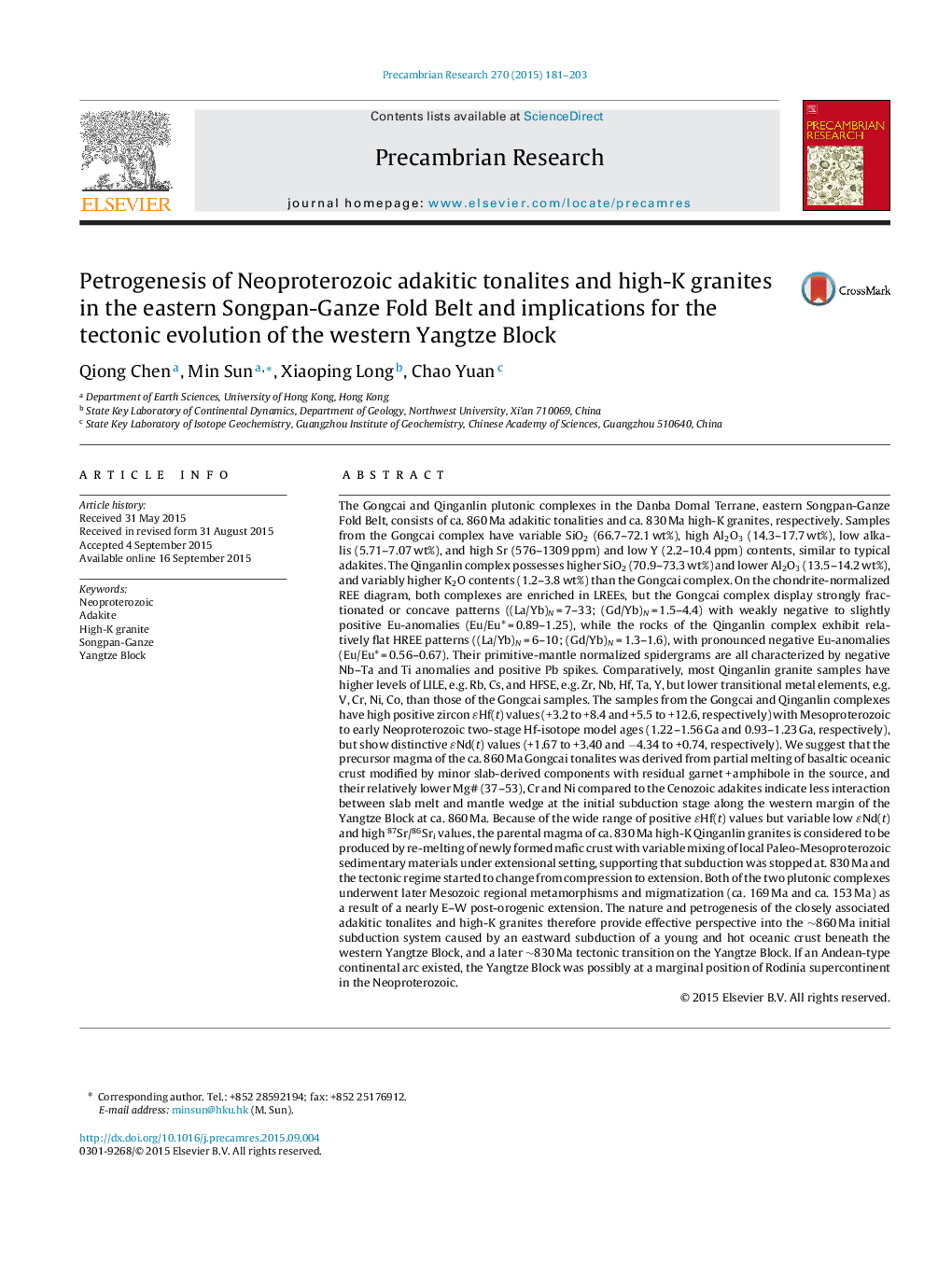| کد مقاله | کد نشریه | سال انتشار | مقاله انگلیسی | نسخه تمام متن |
|---|---|---|---|---|
| 4722462 | 1639605 | 2015 | 23 صفحه PDF | دانلود رایگان |

• The ca. 860 Ma adakitic tonalites was probably derived from oceanic slab.
• The ca. 830 Ma high-K granites was generated by melting of juvenile mafic crust.
• A ca.830 Ma tectonic transition may prevail in the entire Yangtze Block.
The Gongcai and Qinganlin plutonic complexes in the Danba Domal Terrane, eastern Songpan-Ganze Fold Belt, consists of ca. 860 Ma adakitic tonalities and ca. 830 Ma high-K granites, respectively. Samples from the Gongcai complex have variable SiO2 (66.7–72.1 wt%), high Al2O3 (14.3–17.7 wt%), low alkalis (5.71–7.07 wt%), and high Sr (576–1309 ppm) and low Y (2.2–10.4 ppm) contents, similar to typical adakites. The Qinganlin complex possesses higher SiO2 (70.9–73.3 wt%) and lower Al2O3 (13.5–14.2 wt%), and variably higher K2O contents (1.2–3.8 wt%) than the Gongcai complex. On the chondrite-normalized REE diagram, both complexes are enriched in LREEs, but the Gongcai complex display strongly fractionated or concave patterns ((La/Yb)N = 7–33; (Gd/Yb)N = 1.5–4.4) with weakly negative to slightly positive Eu-anomalies (Eu/Eu* = 0.89–1.25), while the rocks of the Qinganlin complex exhibit relatively flat HREE patterns ((La/Yb)N = 6–10; (Gd/Yb)N = 1.3–1.6), with pronounced negative Eu-anomalies (Eu/Eu* = 0.56–0.67). Their primitive-mantle normalized spidergrams are all characterized by negative Nb–Ta and Ti anomalies and positive Pb spikes. Comparatively, most Qinganlin granite samples have higher levels of LILE, e.g. Rb, Cs, and HFSE, e.g. Zr, Nb, Hf, Ta, Y, but lower transitional metal elements, e.g. V, Cr, Ni, Co, than those of the Gongcai samples. The samples from the Gongcai and Qinganlin complexes have high positive zircon ɛHf(t) values (+3.2 to +8.4 and +5.5 to +12.6, respectively) with Mesoproterozoic to early Neoproterozoic two-stage Hf-isotope model ages (1.22–1.56 Ga and 0.93–1.23 Ga, respectively), but show distinctive ɛNd(t) values (+1.67 to +3.40 and −4.34 to +0.74, respectively). We suggest that the precursor magma of the ca. 860 Ma Gongcai tonalites was derived from partial melting of basaltic oceanic crust modified by minor slab-derived components with residual garnet + amphibole in the source, and their relatively lower Mg# (37–53), Cr and Ni compared to the Cenozoic adakites indicate less interaction between slab melt and mantle wedge at the initial subduction stage along the western margin of the Yangtze Block at ca. 860 Ma. Because of the wide range of positive ɛHf(t) values but variable low ɛNd(t) and high 87Sr/86Sri values, the parental magma of ca. 830 Ma high-K Qinganlin granites is considered to be produced by re-melting of newly formed mafic crust with variable mixing of local Paleo-Mesoproterozoic sedimentary materials under extensional setting, supporting that subduction was stopped at. 830 Ma and the tectonic regime started to change from compression to extension. Both of the two plutonic complexes underwent later Mesozoic regional metamorphisms and migmatization (ca. 169 Ma and ca. 153 Ma) as a result of a nearly E–W post-orogenic extension. The nature and petrogenesis of the closely associated adakitic tonalites and high-K granites therefore provide effective perspective into the ∼860 Ma initial subduction system caused by an eastward subduction of a young and hot oceanic crust beneath the western Yangtze Block, and a later ∼830 Ma tectonic transition on the Yangtze Block. If an Andean-type continental arc existed, the Yangtze Block was possibly at a marginal position of Rodinia supercontinent in the Neoproterozoic.
Journal: Precambrian Research - Volume 270, November 2015, Pages 181–203